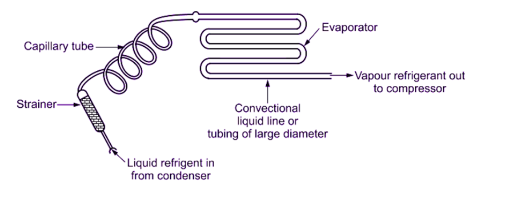Table of Contents
Introduction to Capillary Tubes
Capillary tubes are narrow, long tubes used in various scientific and industrial applications. They operate based on the principle of capillarity, where liquids rise or fall in thin tubes due to surface tension.
In this article, we will explore the uses, working principle, formula, size, and applications of capillary tubes.
Capillary tube in physics
A capillary tube is typically composed of a tube, armour, and a protective sleeve.
The internal diameter of the capillary tube is tiny, making it an ideal way to separate a pressure instrument, such as a gauge or transmitter, from the process of tapping/connection.
Capillary tubing is used to separate the direct connection between the measuring instrument and the process tapping point.

Capillary tube uses
- Capillary tubes find widespread use in different fields, including refrigeration, physics, chemistry labs, and more.
- In refrigeration systems, capillary tubes act as expansion devices, regulating the flow of refrigerant and maintaining the desired temperature. It allows for the isolation of the measuring instrument from the process connection, such as a pressure gauge or transmitter.
- Capillary tube in chemistry lab is used for precise liquid measurements, sample handling, and chromatography.
Working Principle and Formula
The working principle of capillary tubes is based on capillarity, which results from cohesive and adhesive forces between liquids and solids. The formula for capillary rise or fall in a tube involves surface tension, tube radius, and the contact angle between the liquid and tube walls.
It functions as an expansion device in the refrigeration system. As a result, during refrigerant flow through the capillary tube, high-pressure, low-temperature liquid refrigerant should become low-pressure, low-temperature liquid refrigerant.
High pressure is condenser pressure in a refrigeration system, while low pressure is evaporator pressure. As a result, the capillary tube’s job is “to create a pressure drop by lowering the pressure of liquid refrigerant from condenser pressure to evaporator pressure.”
The quantity or extent of pressure drop through a capillary tube is determined by its internal diameter and length. When the high-pressure, low-temperature liquid refrigerant leaving the condenser coils is forced down a capillary tube, frictional resistance develops between the liquid refrigerant and the inner surface of the small-diameter capillary tube.
Capillary tube size
Capillary tubes come in various sizes, ranging from a few millimeters to several centimeters in length, and with different inner diameters. The size chosen depends on the specific application and the liquid being used.
Capillary tubes ranging from 1/16 inch to 1/8 inch in diameter are employed in instrumentation applications. Capillaries of appropriate diameter are employed for best performance.
Applications of Capillary Tubes
- Refrigeration
Capillary tube refrigeration is used to control the flow of refrigerant and regulate the cooling process.
- Chemistry Labs
Capillary tube uses in laboratory for precise liquid measurements, capillary electrophoresis, and chromatography.
- Medical Field
Capillary tubes are used in medical applications for blood sample collection and analysis.
- Physics Experiments
In physics experiments, capillary tubes are used to study fluid mechanics and capillary phenomena.
- Microfluidics
Capillary tubes find application in microfluidic devices for controlling the flow of small volumes of liquid.
Conclusion
Capillary tubes are essential components in various scientific and industrial applications due to their ability to regulate liquid flow and their precise measurement capabilities. Understanding the uses, working principle, formula, size, and applications of capillary tubes helps us appreciate their significance in different fields of science and technology.
Frequently Asked Questions on Capillary Tubes
What are the main uses of capillary tubes?
Capillary tubes find versatile applications in various fields, including refrigeration systems to regulate refrigerant flow, chemistry labs for precise liquid measurements and chromatography, and medical settings for blood sample collection and analysis.
How does the capillary tube work?
Capillary tubes operate based on the principle of capillarity, where liquids rise or fall in thin tubes due to cohesive and adhesive forces between the liquid and the tube walls. This phenomenon is governed by surface tension, tube radius, and the contact angle between the liquid and the tube.
What is the capillary tube formula in a tube?
The formula for capillary rise involves surface tension (T), tube radius (r), and the contact angle (θ) between the liquid and the tube walls. The capillary tube formula is given by h = (2T cos θ)/(ρgr), where h is the capillary rise, ρ is the density of the liquid, and g is the acceleration due to gravity.
What are the typical sizes of capillary tubes?
Capillary tubes come in various sizes, with lengths ranging from a few millimeters to several centimeters, and inner diameters vary according to the specific application. The size is selected based on the intended use and the properties of the liquid being used.








